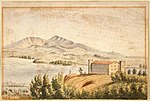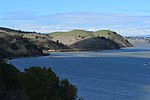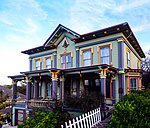Benicia–Martinez Bridge

The Benicia–Martinez Bridge refers to three parallel bridges which cross the Carquinez Strait just west of Suisun Bay in California; the spans link Benicia on the north side with Martinez on the south. The original 1.2-mile (1.9 km) deck truss bridge opened in 1962 to replace the last automotive ferry service in the San Francisco Bay Area. The 1962 bridge has seven 528-foot (161 m) spans and 138 feet (42 m) of vertical clearance, now carrying four lanes of southbound traffic, as well as a path for pedestrians and bicyclists. It was named the George Miller Jr., Memorial Bridge in 1975 after California state legislator George Miller Jr. A 1.7-mile (2.7 km) bridge was built alongside and opened on August 25, 2007 with five lanes of northbound traffic. In 2007, it was named the Congressman George Miller Benicia–Martinez Bridge after U.S. Congressman George Miller, Miller Jr.'s son. The cost of the 1962 span was US$25 million and US$1.3 billion for the 2007 span. (Adjusted for inflation, equivalent to $242 million and $1.83 billion respectively.) The bridge is part of Interstate 680, a major transportation link connecting other heavily traveled freeways. Between the two vehicle bridges is a Union Pacific Railroad bridge, the first bridge at this location, built between April 1929 and October 1930 by Southern Pacific. It is used by Union Pacific and BNSF (trackage rights) freight trains and 36 scheduled Amtrak passenger trains each weekday. Passenger trains include the long-distance trains California Zephyr and Coast Starlight and commuter-oriented Capitol Corridor services.
Excerpt from the Wikipedia article Benicia–Martinez Bridge (License: CC BY-SA 3.0, Authors, Images).Benicia–Martinez Bridge
Benicia-Martinez Bridge,
Geographical coordinates (GPS) Address Nearby Places Show on map
Geographical coordinates (GPS)
| Latitude | Longitude |
|---|---|
| N 38.0406 ° | E -122.123 ° |
Address
George Miller Jr., Memorial Bridge
Benicia-Martinez Bridge
94553
California, United States
Open on Google Maps






